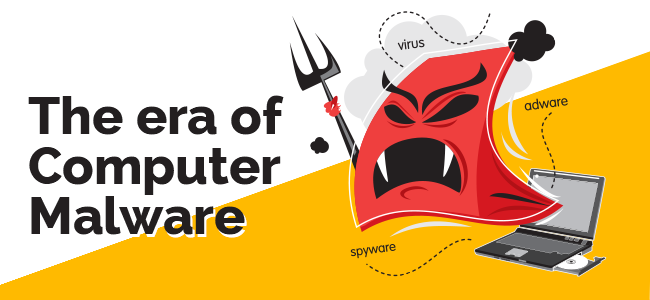The relationship of computers with malwares is somewhat like Yin and Yang; they have contributed to each other’s development to this day, and inadvertently give business to one another. The existence of malwares is considered more bad then good, but there have been times in history when malwares were purposely designed for experimentation and learning. It was not until the time when people started creating malicious programs for harming to a network, when the cyber community started feeling uneasy.
So how did malwares come to the point where they are today? What’s the price we are paying for the damage they are doing, and where are we headed with them? These are some of the prevalent questions haunting the present world today, and we will try our bit to address the questions in this article. For the sake of clarity, we are using the term “malware” as a blanket term to denote virus, Trojans, and all sundry malicious software, because malware is the broadest term to define them all.
History
Looking back, it’s hard to imagine a world without antivirus. Computer technology was taking baby steps, and the word ‘virus’ had not yet been coined. In fact, it was first used by Frederick Cohen in a fictional novel that came out in 1983. Back then, malicious files were accidental results of juxtaposed coding, or a topic of speculation about what would happen if computers had minds of their own.
One of the first big cases of a malwares came to light in 1981 when a program called Elk Cloner, authored by Richard Skrenta, began spreading in Apple DOS machines which, when affected, displayed a tongue-in-cheek poem on the computer screen. It spread through Apple machines and created some ripples in the public domain.
Similarly in 1986, when two brothers who owned a computer store in Lahore, Pakistan wrote a code called “Brain” (named after their business outlet) to protect their medical software against copyright infringement. Little did they know that Brain’s boot sector would soon replace a floppy’s boot sector and disk label with it’s name, and spread like wildfire till the UK and even USA. Although harmless, the problem became a nuisance for IBM PC (powered by MS DOS) users.
More instances like these fuelled active discussions in the tech community about virus as a possible threat to the computers and ways to curb their harm.
The Damage
What started as a humble beginning of testing new technology and accidental discoveries have now led to a lucrative industry for businesses on both sides of the fences. Thanks to the ever-growing range of threats that malwares pose to the infosec industry, the global antivirus market is valued at a whopping $77 billion in 2015, and projected to be worth more than $170 billion by the year 2020.
On the other hand, malware-related cybercrime accounts for as much as $55 billion per year, as far as the business sector is concerned. According to reports, the cost is calculated based on the average of 1.5 millions virus attacks that take place annually.
One of the first viruses to send shock waves across the globe due to the collateral damage it caused was the ILOVEYOU virus. Within a week of its release in 2000, ILOVEYOU caused businesses all around the world to loose $5.5 billion, and the eventual damage totalled to $15 billion – a record high at the time.
Similarly, Sobig was another infamous virus that spread through email in 2003 and wreaked havoc worth over $37 billion. Perhaps the most notorious of them all was Mydoom virus, which crippled the cyberworld and shook the industry’s confidence by causing a loss of nearly $38 billion. Dubbed as the fastest spreading virus, Mydoom was unleashed in 2004 and affected almost a quarter percent of all emails.
As the pattern clearly shows, malware perpetrators are getting better at putting a dent to the economy. While the security sector is fast catching up with the modus operandi malware authors use, the safety measures need to be enhanced periodically for avoiding monetary and huge data loss.
What’s next
With the power of internet at their disposal, online consumers now have a ready access to malware search engines to analyze malicious files and URLs, which enables them to select the appropriate tools to treat them accordingly from harming their system.
But nobody is really winning in the tug of war between the malware creators and antivirus industry, although the cybercriminals are raking profits out of their illegal means. While there are groups of experts that have been forecasting the “death of antivirus” programs since many years, their claims have been proven wrong so far. Their claim that something else – such as, application control techniques – would replace the antivirus products has not seen the light of the day yet, and probably won’t in the near future.
However, it is true that the antivirus industry in general have hit a plateau because they have been employing the same tricks instead of innovating better remedies. With new and sophisticated malwares making news every now and then, it remains to be seen how antivirus manufacturers will emulate the industry’s expectations of being the saviour of the cyberworld, the guardian of the interweb.





